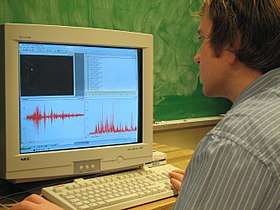Electromyography
| Electromyography | |
|---|---|
| Intervention | |

EMG from gait termination, bottom left is the raw EMG, right is the rectified pattern
|
|
| ICD-9-CM | 93.08 |
| MeSH | D004576 |
Electromyography (EMG) is an electrodiagnostic medicine technique for evaluating and recording the electrical activity produced by skeletal muscles. EMG is performed using an instrument called an electromyograph to produce a record called an electromyogram. An electromyograph detects the electric potential generated by muscle cells when these cells are electrically or neurologically activated. The signals can be analyzed to detect medical abnormalities, activation level, or recruitment order, or to analyze the biomechanics of human or animal movement.
EMG testing has a variety of clinical and biomedical applications. EMG is used as a diagnostics tool for identifying neuromuscular diseases, or as a research tool for studying kinesiology, and disorders of motor control. EMG signals are sometimes used to guide botulinum toxin or phenol injections into muscles. EMG signals are also used as a control signal for prosthetic devices such as prosthetic hands, arms, and lower limbs.
EMG then an acceleromyograph may be used for neuromuscular monitoring in general anesthesia with neuromuscular-blocking drugs, in order to avoid postoperative residual curarization (PORC).
Except in the case of some purely primary myopathic conditions EMG is usually performed with another electrodiagnostic medicine test that measures the conducting function of nerves. This is called a nerve conduction studies (NCS). Needle EMG and NCSs are typically indicated when there is pain in the limbs, weakness from spinal nerve compression, or concern about some other neurologic injury or disorder. Spinal nerve injury does not cause neck, mid back pain or low back pain, and for this reason, evidence has not shown EMG or NCS to be helpful in diagnosing causes of axial lumbar pain, thoracic pain, or cervical spine pain. Needle EMG may aid with the diagnosis of nerve compression or injury (such as carpal tunnel syndrome), nerve root injury (such as sciatica), and with other problems of the muscles or nerves. Less common medical conditions include amyotrophic lateral sclerosis, myasthenia gravis, and muscular dystrophy.
...
Wikipedia
